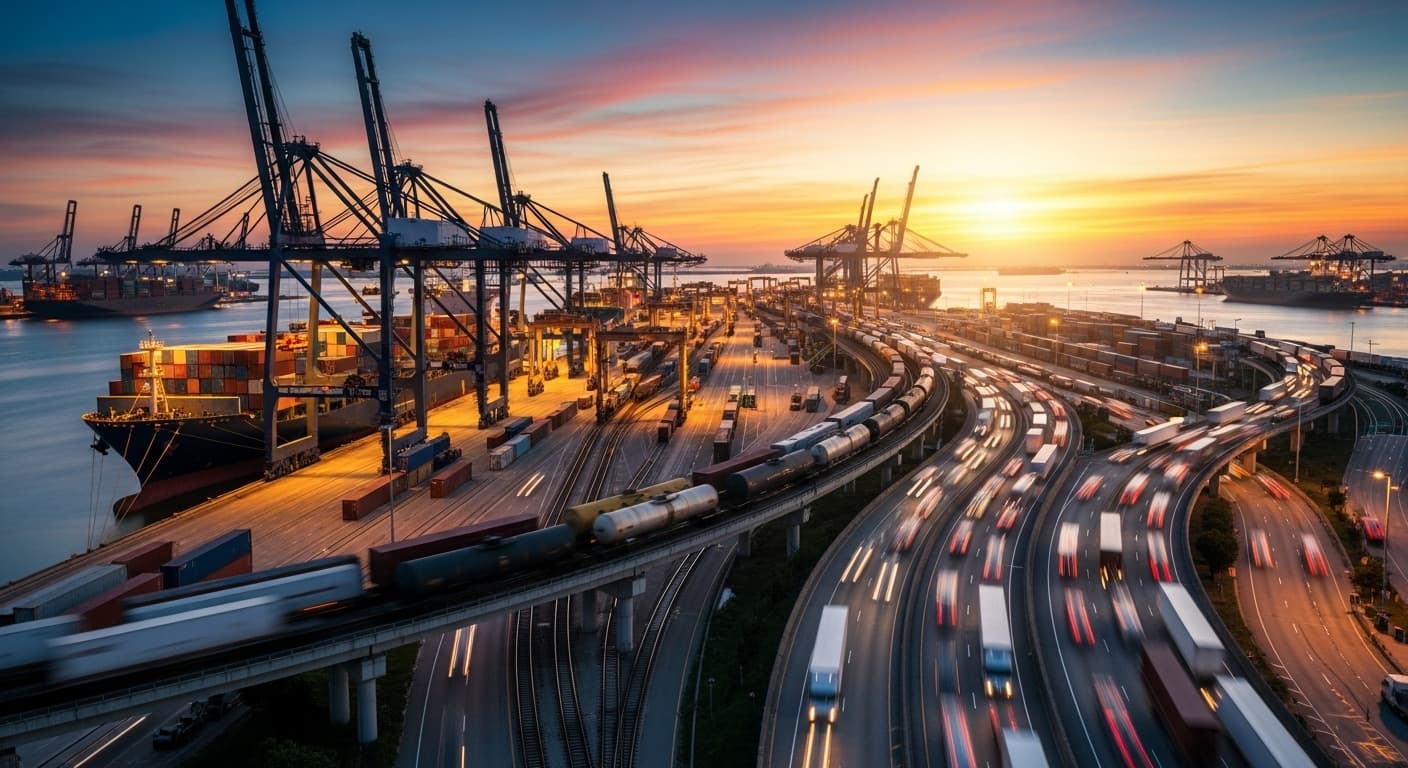
Executive Summary
The Infrastructure Investment and Jobs Act represents the most substantial federal commitment to American infrastructure in decades, allocating $1.2 trillion toward transportation network modernization with significant implications for logistics operations. Improvements to highways, bridges, ports, rail systems, and digital infrastructure promise enhanced freight efficiency, reduced costs, and improved supply chain reliability. Understanding implementation timelines, priority projects, and strategic implications enables logistics organizations to position themselves advantageously as infrastructure improvements materialize across the national transportation network.
US Infrastructure Investment: Transforming Logistics Through Transportation Network Modernization
(美国基础设施投资:通过交通网络现代化改造物流)
1 · Infrastructure Investment Framework and Scope
The Infrastructure Investment and Jobs Act establishes comprehensive framework for transportation infrastructure modernization affecting multiple dimensions of logistics operations.
Legislative Foundation
IIJA Overview: The Infrastructure Investment and Jobs Act, signed into law in November 2021, authorized approximately $1.2 trillion in infrastructure spending over multiple years representing largest federal infrastructure commitment in decades.
Transportation Focus: While IIJA addresses various infrastructure categories including broadband and water systems, substantial portions target transportation infrastructure directly relevant to logistics including highway and bridge improvements, port and waterway infrastructure, rail system enhancements, and intermodal connectivity projects.
Implementation Timeline: IIJA funding flows over five-year period from federal fiscal years 2022 through 2026, with projects progressing through planning, design, and construction phases extending benefits over longer timeframes as projects complete.
Funding Allocation
Highway and Road Infrastructure: Over $300 billion allocated for highway and bridge improvements represents largest single category including interstate highway system maintenance and expansion, bridge repair and replacement programs, safety improvement projects, and state and local road funding.
Port and Waterway Investment: Approximately $17 billion designated for maritime infrastructure including port infrastructure grants, channel deepening and dredging projects, inland waterway improvements, and coastal port resilience enhancements.
Rail System Funding: $66 billion allocated for rail infrastructure supports both passenger and freight rail improvements including track and signal system upgrades, grade crossing safety improvements, and intermodal facility development.
Multimodal and Emerging Technologies: Additional funding supports intelligent transportation systems, alternative fuel infrastructure, and innovative project development encouraging modernization and technology adoption.
2 · Highway Infrastructure Improvements
Highway system enhancements directly affect trucking operations representing dominant freight transportation mode in United States.
Interstate System Modernization
Capacity Expansion: Strategic capacity additions on congested interstate corridors reduce bottlenecks and improve freight flow:
Additional Lanes: Adding lanes on heavily-traveled freight corridors increases throughput reducing congestion during peak periods and providing greater reliability for time-sensitive shipments.
Truck Climbing Lanes: Dedicated climbing lanes on grades enable trucks to maintain reasonable speeds without impeding faster traffic improving safety and flow.
Interchange Improvements: Modernizing interchange designs reduces conflict points, improves traffic flow, and accommodates larger truck turning radii supporting efficient freight movement.
Bridge Repair and Replacement
Structural Deficiency: Thousands of bridges across United States have been classified as structurally deficient or functionally obsolete requiring repair or replacement:
Weight Restrictions: Deficient bridges often carry weight restrictions forcing trucks to use longer alternative routes. Bridge improvements eliminate these restrictions reducing unnecessary miles and improving efficiency.
Reliability Enhancement: Modern bridges provide greater reliability reducing unexpected closures for emergency repairs that disrupt freight routing and scheduling.
Pavement Condition
Surface Quality: Road surface condition significantly affects fuel efficiency, vehicle maintenance costs, and driver comfort:
Fuel Economy Impact: Rough pavement increases rolling resistance reducing fuel economy. Improved pavement conditions yield measurable fuel savings across trucking fleets.
Maintenance Cost Reduction: Better road surfaces reduce vehicle wear and tear lowering maintenance costs for tires, suspension systems, and other components.
Safety Improvements: Quality pavement provides better traction and visibility supporting safer operations particularly in adverse weather conditions.
3 · Port and Maritime Infrastructure Development
Port infrastructure improvements enhance capacity, efficiency, and competitiveness of American gateway facilities handling international trade.
Channel Deepening Projects
Vessel Size Accommodation: Modern container ships have grown substantially larger than vessels from previous decades requiring deeper channels:
Post-Panamax Vessels: Ships too large for original Panama Canal dimensions now call at major US ports. Adequate channel depth enables these vessels to operate at full capacity rather than arriving partially loaded.
Economic Benefits: Deeper channels allow larger vessels improving shipping economics through economies of scale. Ports unable to accommodate these vessels lose competitiveness.
Dredging Programs: Regular maintenance dredging and capital deepening projects maintain and enhance channel depths supporting current and future vessel requirements.
Terminal and Berth Infrastructure
Cargo Handling Capacity: Modern terminal facilities improve cargo handling efficiency:
Berth Capacity: Additional berths and longer berth faces accommodate more vessels simultaneously reducing vessel waiting times and improving port throughput.
Yard Space: Expanded container yards provide staging areas for import and export cargo reducing congestion and improving container flow through terminals.
Equipment Modernization: Investment in modern cranes, handling equipment, and terminal operating systems improves productivity and reduces dwell times.
Landside Connectivity
Rail and Highway Access: Efficient connections between ports and inland transportation networks prevent terminal-side bottlenecks:
On-Dock Rail: Direct rail connections to marine terminals enable efficient container transfer between ships and trains without truck drayage reducing costs and congestion.
Highway Improvements: Grade separations, additional lanes, and improved access roads move cargo efficiently between ports and regional distribution networks.
4 · Rail Infrastructure Enhancement
Rail system improvements affect both intermodal freight operations and bulk commodity movements across American freight network.
Track and Signal Modernization
Capacity and Speed: Track improvements enable higher speeds and greater throughput:
Class Standards: Railroad track classified by condition and maintenance standards determines maximum allowable speeds. Upgrading track class enables faster freight movements.
Signaling Systems: Modern signal systems including positive train control improve safety while enabling more trains to operate on given track segments increasing effective capacity.
Siding and Double Track: Additional sidings and double-track segments reduce train conflicts improving velocity and reliability particularly on single-track main lines.
Intermodal Facility Development
Container Transfer: Modern intermodal terminals efficiently transfer containers between rail and truck:
Capacity Expansion: Growing intermodal volumes require expanded terminal capacity to prevent congestion and maintain fluid operations.
Equipment Investment: Cranes, reach stackers, and related equipment determines terminal productivity and throughput capability.
Technology Integration: Terminal operating systems coordinate equipment movements, optimize storage locations, and manage documentation supporting efficient operations.
Grade Crossing Safety
Public Safety and Efficiency: Railroad crossings of highways create safety concerns and operational constraints:
Grade Separations: Constructing overpasses or underpasses eliminates conflicts between rail and highway traffic improving both safety and traffic flow.
Crossing Protection: Where grade separations aren’t feasible, improved warning systems and crossing surfaces enhance safety.
5 · Operational Impact on Logistics Efficiency
Infrastructure improvements translate directly into operational benefits measurable across various logistics performance dimensions.
Transit Time Reduction
Faster Freight Movement: Infrastructure improvements reduce travel times through various mechanisms:
Congestion Relief: Capacity additions and bottleneck elimination reduce time spent in congested conditions particularly in major metropolitan areas and freight corridors.
Route Optimization: Elimination of weight-restricted bridges and improved connectivity enables more direct routing reducing unnecessary mileage.
Reliability Improvement: Better infrastructure reduces likelihood of unexpected closures and disruptions making scheduled transit times more achievable and predictable.
Cost Reduction
Operating Expense Impact: Multiple cost categories benefit from infrastructure improvements:
Fuel Efficiency: Reduced congestion, better pavement quality, and more direct routing all contribute to lower fuel consumption per ton-mile improving operating economics.
Maintenance Costs: Better road surfaces reduce vehicle wear and tear lowering maintenance expenses for trucks and extending vehicle life.
Labor Productivity: Reduced transit times mean drivers complete more deliveries within hours-of-service constraints improving labor productivity and asset utilization.
Reliability and Service Quality
Predictable Operations: Infrastructure improvements enhance operational predictability:
Schedule Adherence: More reliable travel times enable better schedule adherence improving customer service and reducing costs associated with delays.
Exception Reduction: Fewer infrastructure-related disruptions mean fewer exceptions requiring intervention and exception management.
Planning Confidence: Greater reliability enables more confident planning supporting just-in-time operations and inventory optimization.
6 · Strategic Implications for Logistics Organizations
Infrastructure investments create strategic considerations for logistics providers and shippers regarding network design, facility location, and operational approaches.
Network Design Optimization
Facility Location Reassessment: Infrastructure improvements may change optimal facility locations:
New Hub Opportunities: Improved highway corridors, enhanced port access, or upgraded rail connections may create attractive locations for distribution centers and cross-dock facilities that previously weren’t optimal.
Market Access: Better infrastructure expands practical service areas from given locations enabling coverage of more territory from single facility or conversely allowing consolidation of multiple smaller facilities.
Competitive Positioning: Early recognition of infrastructure-driven location advantages enables strategic positioning ahead of competitors.
Modal Strategy Evolution
Intermodal Opportunities: Rail infrastructure improvements enhance intermodal competitiveness:
Service Expansion: Better rail infrastructure and terminal capacity enable intermodal service expansion into markets or lanes previously served primarily by truck.
Cost Competitiveness: Rail efficiency improvements strengthen intermodal cost advantages supporting modal shift where service characteristics permit.
Environmental Benefits: Rail’s environmental advantages over trucking become increasingly relevant as sustainability considerations grow in importance.
Technology Integration
Smart Infrastructure Utilization: Digital infrastructure investments create opportunities:
Real-Time Information: Connected infrastructure provides real-time traffic conditions, incident information, and predictive analytics supporting dynamic routing and optimization.
Automated Systems: Digital payment systems, weigh-in-motion scales, and electronic inspection capabilities reduce delays and improve efficiency.
Visibility Enhancement: Integration of infrastructure data with fleet management and visibility platforms provides comprehensive supply chain transparency.
7 · Regional Variations and Priority Corridors
Infrastructure investment impacts vary geographically based on funding allocation, project selection, and regional characteristics.
Major Freight Corridors
Interstate Freight Network: Certain corridors receive priority attention given their importance to national freight movement:
East-West Corridors: I-70, I-80, and other major east-west routes connecting ports to interior markets receive substantial investment given high freight volumes.
North-South Routes: I-5, I-35, I-95, and parallel routes moving freight along coasts and connecting with Mexico receive priority investment.
Regional Connectors: Routes connecting major freight corridors with regional markets and production areas also benefit from infrastructure programs.
Gateway Enhancement
Major Port Regions: Ports and their surrounding transportation networks receive focused investment:
Los Angeles/Long Beach: Nation’s largest port complex receives substantial funding for port infrastructure, highway improvements, and rail enhancement supporting increased capacity.
East Coast Ports: Ports from Miami to New York benefit from channel deepening, terminal improvements, and landside connectivity enhancements.
Gulf Coast Facilities: Houston, New Orleans, and other Gulf ports receive investment supporting petrochemical and general cargo operations.
Emerging Logistics Hubs
Secondary Market Development: Infrastructure investment supports logistics growth in emerging markets beyond traditional primary hubs offering cost advantages and strategic positioning.
8 · Implementation Timeline and Phasing
Understanding project timelines helps logistics organizations plan strategically for evolving infrastructure capabilities.
Near-Term Improvements
Currently Active Projects: Various projects initiated in early IIJA implementation phases approach completion:
Quick-Win Projects: Smaller-scale improvements including pavement rehabilitation, bridge repairs, and equipment upgrades provide relatively rapid benefits.
Ongoing Programs: State DOT programs utilizing IIJA formula funding deliver steady stream of improvements across highway networks.
Medium-Term Developments
Major Capital Projects: Large-scale infrastructure projects require extended planning and construction timelines:
Port Expansions: Terminal development and channel deepening projects typically require multiple years from planning through construction completion.
Highway Reconstruction: Major highway corridor improvements proceed in phases balancing construction progress with traffic management.
Rail Infrastructure: Track improvements, signal system upgrades, and terminal developments follow multi-year implementation schedules.
Long-Term Transformation
Sustained Investment: Beyond IIJA five-year authorization, infrastructure needs require sustained long-term investment:
Maintenance Requirements: New infrastructure requires ongoing maintenance to preserve condition and performance.
Future Capacity: Growing freight volumes necessitate continuous capacity enhancement beyond current investments.
Technology Evolution: Emerging technologies including autonomous vehicles, alternative fuels, and digital infrastructure require forward-looking investment.
9 · Challenges and Considerations
Infrastructure improvement programs face various challenges affecting implementation speed, costs, and ultimate benefits.
Funding and Resource Constraints
Budget Limitations: While IIJA represents substantial investment, identified infrastructure needs exceed available funding requiring prioritization and phasing.
State Matching Requirements: Many federal programs require state or local matching funds that may be challenging for jurisdictions with limited resources.
Competing Priorities: Limited resources must be allocated across maintenance, safety, capacity expansion, and modernization creating difficult tradeoffs.
Implementation Complexity
Regulatory Processes: Environmental reviews, permitting requirements, and public involvement processes create extended timelines before construction begins.
Right-of-Way Acquisition: Property acquisition for highway expansion or facility development can be time-consuming and expensive.
Construction Impacts: Work zones and construction activities create temporary disruptions before ultimate improvements provide benefits.
Market Uncertainty
Demand Forecasting: Long project timelines create uncertainty about future freight patterns and requirements potentially affecting project relevance by completion.
Technology Change: Rapid technology evolution may change infrastructure requirements over project development timelines.
10 · Conclusion: Positioning for Infrastructure-Enabled Opportunities
Transformation Significance
Generational Investment: IIJA represents most substantial federal infrastructure commitment in decades creating generational opportunity to modernize American transportation networks supporting logistics efficiency and economic competitiveness.
Multifaceted Benefits: Infrastructure improvements provide multiple benefits including reduced transit times, lower operating costs, improved reliability and service quality, and enhanced safety and environmental performance.
Sustained Impact: While individual projects complete over years, collective impact unfolds over decades as improved infrastructure supports logistics operations and economic activity.
Strategic Positioning
Proactive Planning: Organizations should proactively monitor infrastructure developments, assess implications for network design and operations, and position strategically to capitalize on emerging opportunities.
Flexible Strategies: Given implementation uncertainties and extended timelines, strategies should maintain flexibility adapting as projects progress and circumstances evolve.
Collaborative Engagement: Participation in planning processes, advocacy for priority improvements, and partnerships with public agencies help shape outcomes supporting industry needs.
Competitive Advantage
Early Adoption: Organizations that recognize and respond early to infrastructure-driven opportunities gain competitive advantages through superior network positioning, enhanced efficiency, and better cost structures.
Continuous Adaptation: As infrastructure continues evolving, successful organizations maintain awareness of developments and continuously adapt strategies and operations optimizing for changing conditions.
The Infrastructure Investment and Jobs Act creates foundation for substantially improved logistics efficiency across American transportation networks. While full benefits materialize over extended timeframes as projects complete, the transformation underway promises meaningful improvements in freight transportation performance. Organizations that understand infrastructure developments, assess strategic implications thoughtfully, and position themselves appropriately will benefit most from this historic investment in American logistics infrastructure.
This analysis reflects current understanding of IIJA implementation and infrastructure development based on publicly available information and industry intelligence. Specific project timelines, scope, and outcomes may vary based on funding availability, regulatory processes, and local circumstances. Organizations making strategic decisions based on infrastructure developments should monitor official announcements and consult with transportation planners and industry specialists who can provide guidance specific to their particular markets and requirements.


